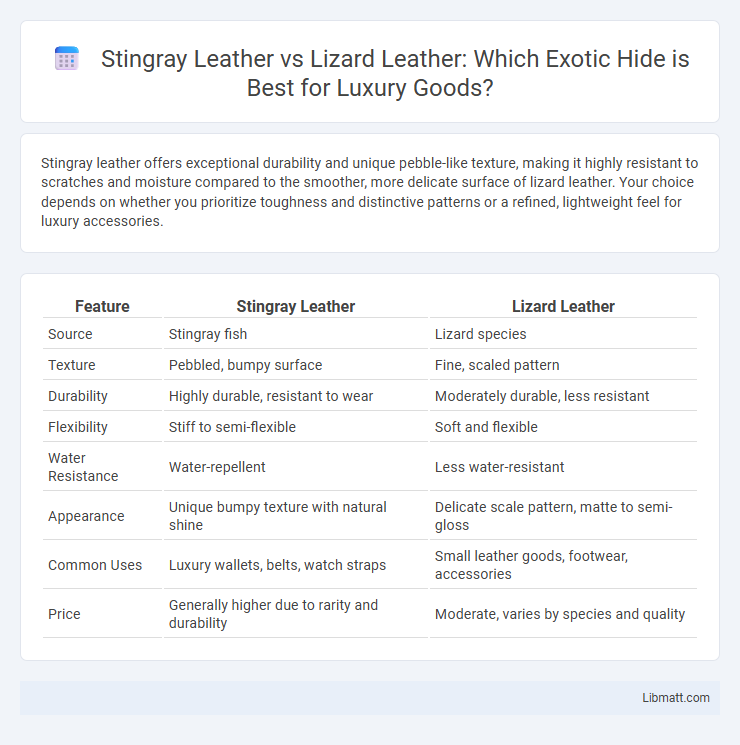Stingray leather offers exceptional durability and unique pebble-like texture, making it highly resistant to scratches and moisture compared to the smoother, more delicate surface of lizard leather. Your choice depends on whether you prioritize toughness and distinctive patterns or a refined, lightweight feel for luxury accessories.
Table of Comparison
| Feature | Stingray Leather | Lizard Leather |
|---|---|---|
| Source | Stingray fish | Lizard species |
| Texture | Pebbled, bumpy surface | Fine, scaled pattern |
| Durability | Highly durable, resistant to wear | Moderately durable, less resistant |
| Flexibility | Stiff to semi-flexible | Soft and flexible |
| Water Resistance | Water-repellent | Less water-resistant |
| Appearance | Unique bumpy texture with natural shine | Delicate scale pattern, matte to semi-gloss |
| Common Uses | Luxury wallets, belts, watch straps | Small leather goods, footwear, accessories |
| Price | Generally higher due to rarity and durability | Moderate, varies by species and quality |
Introduction to Exotic Leathers
Stingray leather is renowned for its durability and distinctive pebble-like texture, featuring natural calcium deposits that create a unique star-shaped pattern often sought in luxury accessories. Lizard leather, prized for its fine, smooth scales and flexible nature, offers an elegant finish ideal for high-end fashion items and watch straps. Both exotic leathers provide exceptional strength and aesthetic appeal, each with unique characteristics that cater to specific design and style preferences in the fashion industry.
Stingray Leather: Key Features
Stingray leather is renowned for its exceptional durability, water resistance, and distinctive pebble-like texture caused by natural calcium carbonate deposits on the skin's surface. Its unique appearance includes a prominent central "eye" or pearl, making each hide visually striking and highly sought after in luxury goods. Your choice of stingray leather offers both long-lasting strength and a bold, exotic aesthetic unmatched by lizard leather.
Lizard Leather: Key Features
Lizard leather is renowned for its fine, small-scale pattern and smooth texture, making it highly sought after for luxury accessories like wallets and watch bands. Its natural flexibility and lightweight properties offer superior comfort and durability compared to other exotic leathers. The unique, glossy finish of lizard leather enhances its elegance, often preferred in high-end fashion for sophisticated and discreet style.
Durability: Stingray vs Lizard
Stingray leather outperforms lizard leather in durability due to its dense, pebble-like texture and natural calcium deposits that provide exceptional resistance to scratches and wear. Lizard leather, while smooth and elegant, is more delicate and prone to scuffs and abrasion over time. Your choice between these materials should consider stingray leather's superior toughness for long-lasting use versus the refined appearance of lizard leather.
Texture and Appearance Comparison
Stingray leather features a distinctive pebbled texture with a glossy, almost bead-like surface that reflects light, creating a luxurious and exotic appearance. Lizard leather offers a smoother, more refined texture with fine, uniform scales that provide an elegant and subtle pattern. Your choice depends on whether you prefer the bold, textured look of stingray or the sleek, understated beauty of lizard leather.
Color and Pattern Variations
Stingray leather features a unique pebbled texture with a natural, iridescent shine and often appears in pure whites, blacks, or vibrant dyed colors, highlighting its distinctive bead-like pattern. Lizard leather offers finer, small-scale patterns with smooth, elegant scales that come in a broader color range from natural browns and greens to more exotic dyed hues, allowing for subtle to bold style choices. Your selection depends on whether you prefer the bold, eye-catching texture of stingray or the refined, patterned look of lizard leather.
Flexibility and Comfort
Stingray leather is known for its remarkable durability and unique texture, but it tends to be stiffer and less flexible compared to lizard leather. Lizard leather offers superior flexibility and softness, providing greater comfort for wearable items like wallets or watch straps. When choosing between the two, your preference for comfort and ease of movement might make lizard leather the better option.
Maintenance and Care Requirements
Stingray leather requires minimal maintenance due to its natural water resistance and durability, making it ideal for everyday use. Lizard leather needs more delicate care, including regular conditioning to prevent drying and cracking. Your choice between these materials will depend on how much time you can invest in maintaining the leather's appearance and longevity.
Typical Uses and Applications
Stingray leather is commonly used for high-end wallets, belts, and watch straps due to its durability and distinctive pebble-like texture, making it ideal for accessories that require both style and toughness. Lizard leather, prized for its fine scales and smooth finish, is often utilized in luxury handbags, shoes, and small leather goods where a sleek and elegant appearance is desired. Your choice between stingray and lizard leather should consider the intended item's wear resistance and aesthetic appeal.
Price and Value Comparison
Stingray leather commands a higher price due to its durability, unique texture, and water resistance, making it a valuable investment for luxury goods that require longevity. Lizard leather is generally more affordable, prized for its smooth, intricate patterns but less durable, which can affect its long-term value. When comparing price and value, stingray leather offers superior resilience and exclusivity, justifying its premium cost over lizard leather in high-end fashion and accessories.
Stingray leather vs lizard leather Infographic

 libmatt.com
libmatt.com